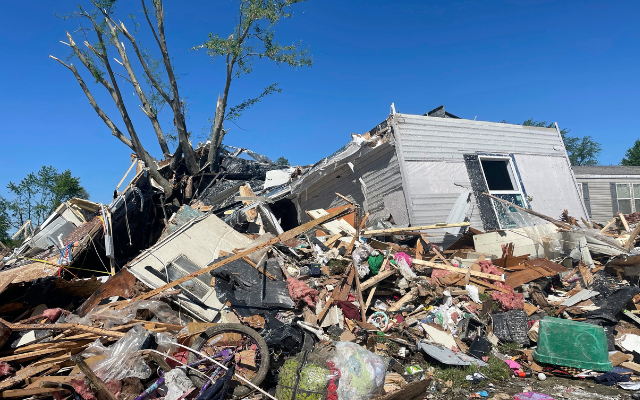Everything You Need to Know About the Coronavirus

CANTON (News Talk 1480 WHBC) – As the coronavirus continues to spread throughout the world, both national and local health officials are working to educated the public on what the virus is and how it can be prevented.
The following information was provided to WHBC News by the Ohio Department of Health.
What is Coronavirus Disease 2019 (COVID-19)?
Coronavirus disease 2019 (COVID-19) is a virus strain, identified as the cause of an outbreak of respiratory illness first detected in Wuhan, Hubei Province, China. Coronaviruses are a large family of viruses, some causing illness in people and others circulating among animals, including camels, cats, and bats. Rarely, animal coronaviruses can evolve and infect people and then spread, such as was seen with Middle East respiratory syndrome (MERS) in 2014 and severe acute respiratory syndrome (SARS) in 2003 and is now being seen with COVID-19.
Why the concern?
COVID-19 has only been identified in humans since December 2019. Health experts are still learning the characteristics of this virus. They are concerned because the disease has the potential to cause severe respiratory illness in some people and, because it is new and not predictable like the flu. There currently is no vaccine to prevent COVID-19 and no specific antiviral treatment.
What is the source of COVID-19?
COVID-19 likely came from an animal because the first cases were linked to a large seafood and animal market, suggesting a possible zoonotic origin to the outbreak. However, more information is needed to figure out the possible role that animals play in transmission of COVID-19.
How does COVID-19 spread and what are the symptoms?
Coronavirus disease 2019 is primarily spread through respiratory droplets, which means to become infected, people generally must be within 6 feet of someone who is contagious and come into contact with these droplets. Symptoms of COVID-19 generally appear within two to 14 days after exposure and include fever, cough, and difficulty breathing. Reported cases have ranged from mild illness (similar to a common cold) to severe pneumonia that requires hospitalization.
How can I prevent it?
Currently, there are no vaccines available to prevent COVID-19 infection. The Centers for Disease Control and Prevention (CDC) recommends typical infectious disease precautions, just as those used to prevent cold or flu:
- Wash your hands often with soap and water for at least 20 seconds.
- Use an alcohol-based hand sanitizer if soap and water are not available.
- Avoid touching your mouth, nose, or eyes.
- Cover coughs/sneezes with your arm or a tissue. Avoid exposure to others who are sick.
- Stay home you are ill (except to visit a health care professional) and avoid close contact with others.
- Get adequate sleep and eat well-balanced meals to ensure a healthy immune system.
- Clean and disinfect frequently touched objects and surfaces.
The CDC does not recommend the routine use of face masks by the general public to prevent respiratory illness and is not recommending their use at this time for the prevention of COVID-19.
How high is my risk of catching COVID-19?
At this time, the virus is not spreading in U.S. communities, and the CDC considers risk to the general public low. While coronavirus disease 2019 is of serious concern, the greater risk is for people who have recently traveled to China, health care workers caring for COVID-19 patients, and other close contacts of COVID-19 patients. It is far more likely that Ohioans will contract flu than COVID-19. The CDC estimates that there have been between 14,000 and 36,000 U.S. deaths from flu this season. There have been no confirmed deaths in the U.S. due to COVID-19. A flu shot is recommended for Ohioans 6-months- old and older who have not yet received one this season; however, the flu vaccine does not protect against COVID-19.
Have there been cases of COVID-19 in the United States?
The CDC has confirmed a handful of COVID-19 cases in the U.S. For current numbers and a map of states with confirmed COVID-19 cases, please visit the CDC website.
What about Ohio?
There are no confirmed cases of COVID-19 in Ohio. For current numbers on people tested for the virus here, please visit the Ohio Department of Health (ODH) main coronavirus webpage at www.odh.ohio.gov/coronavirus. ODH, in coordination with the CDC and local partners, is closely monitoring the outbreak caused by COVID-19. ODH has issued health alerts, and Amy Acton, MD, MPH, Director of ODH, has declared COVID-19 a Class A reportable infectious disease, meaning any possible case must be reported immediately to a local health district, which will report to ODH. ODH will then notify the CDC, where laboratory testing for the virus can take place. ODH, with local health departments and health care providers, actively works 24/7 to monitor, prevent, and control all infectious diseases.
Where have there been confirmed cases of COVID-19 globally?
For an updated list of countries reporting confirmed COVID-19 cases, please visit the CDC website.
How is COVID-19 treated?
There are no medications specifically approved for COVID-19. Most people with mild coronavirus illnesses will recover on their own and may not require hospitalization. However, some people develop pneumonia and require increased medical care or hospitalization.
What if I recently traveled to China?
If you have been in mainland China anytime in the previous 14 days, you should:
- Remain at home or in a comparable setting for 14 days after your arrival to the U.S.
- Monitor yourself for fever and remain alert for cough or difficulty breathing.
- If you develop symptoms, seek advice by telephone from a health care provider or your local health department to determine whether medical evaluation is needed.
What if I had contact with a person under investigation for or confirmed to have COVID-19?
CDC guidelines for people with possible or confirmed cases of COVID-19 and people in close contact with them can be found on the website.
Can I still travel to China or countries where COVID-19 cases have occurred?
The U.S. State Department has issued a Level 4 Travel Advisory, recommending against travel to China. The CDC recommends avoiding all nonessential travel to the country. If you are traveling overseas (to China but also to other places), follow the CDC’s traveler’s health guidance here.
What is happening at U.S. airports?
Details about what to expect at the airport for travelers arriving to the U.$. from China can be found here. As of Sunday, February 2, 2020, all flights and travelers from China are being routed to 11 airports, none in Ohio. U.S. citizens returning to the U.S. who have been in Hubei Province in the previous two weeks are subject to screening and up to 14 days of mandatory quarantine. U.S. citizens returning to the United States who have been to other parts of mainland China within the previous two weeks are subject to screening and up to 14 days of monitored self-quarantine, Foreign citizens who have been to China in the previous two weeks are being denied entry to the U.S., with the exception of immediate family members of U.S. citizens, permanent residents, and flight crews.



